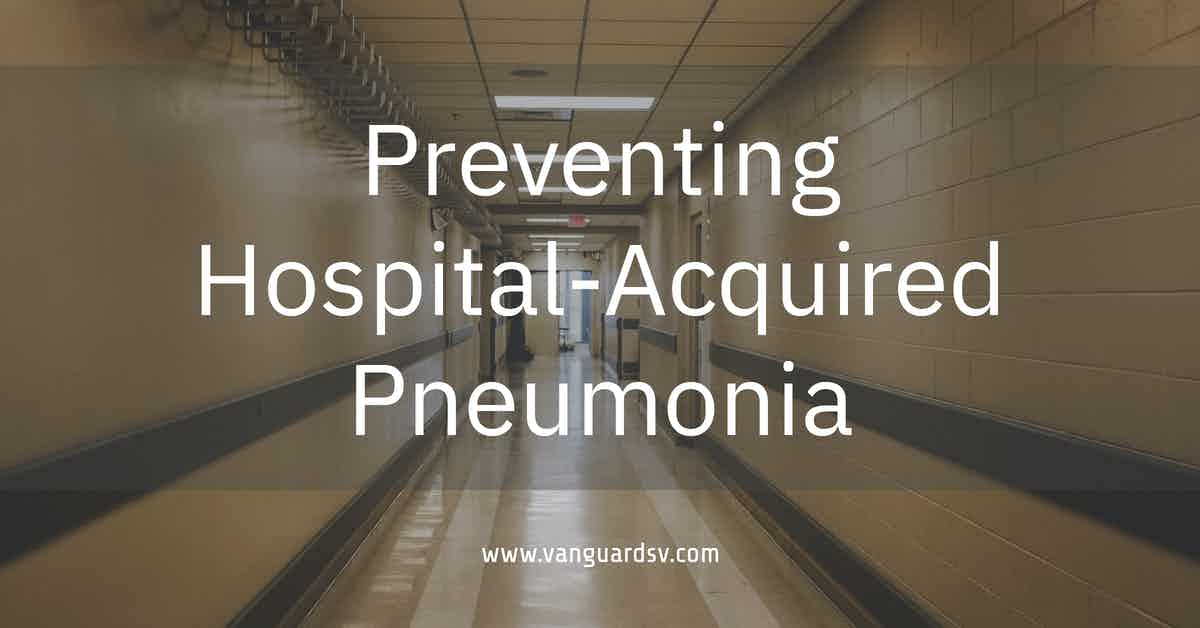Non-Ventilator Hospital-Acquired Pneumonia (NVHAP) is the most common Hospital-Acquired Infection (HAI) in the United States, yet it goes unreported by most healthcare facilities.

Understanding Non-Ventilator Hospital-Acquired Pneumonia
Hospital-Acquired Pneumonia is the most prevalent HAI in the US.
Yet, it goes under or entirely unreported by healthcare facilities due to a lack of requirements or regulation by several significant oversight bodies.
While certain demographics are more at risk than others, HAP affects even healthy patients, resulting in serious negative in-patient outcomes, including rehospitalization, extended stays, ICU admission, and high mortality rates.
According to the National Organization to Prevent Hospital-acquired Pneumonia (NOHAP), most hospitals do not track, report or have initiatives to actively prevent NVHAP, even though it's the most common hospital-acquired infection.
The negative patient outcomes associated with NVHAP include 15-30% mortality, extended hospital length of stay, unexpected ICU admission of up to 46% and increased risk for hospital readmission within 30 days, according to the ICHE paper.
Unlike ventilator-associated pneumonia (VAP) and other device-associated hospital-acquired infections, NVHAP is not recognized as one of the National Database of Nursing Quality indicators, nor do the Centers for Medicare and Medicaid Services (CMS) require hospitals to report cases to the CDC National Healthcare Safety Network or include it in pay-for-reporting or performance programs.
Healthcare Leaders Hope To Prevent Hospital-Acquired Pneumonia
Causes and Risk Factors
HAP is typically caused via aspiration of microorganisms that originate in the intestines, mouth, or nose, most commonly afflicting those who have suffered from a stroke, but also a high risk for patients suffering from:
- Seizures.
- Substance abuse disorder.
- Chronic pulmonary disease (CPD), and;
- Neuromuscular disease, such as Parkinson's or muscular dystrophy.
HAP is also spread via pathogens spread from healthcare workers and the built environment, underscoring the need for increased infection prevention and control measures that include:
- Influenza vaccination.
- Staff training.
- Hand hygiene.
- Surface sanitation, including routine floor care, and;
- PPE adherence.
According to American Nurse;
HAP also can be acquired from pathogens transmitted via healthcare workers and hospital equipment.
For this reason, all healthcare workers must strictly adhere to infection prevention standards, especially when caring for patients in the acute care setting, who are at a greater risk for developing pneumonia because they may be immunocompromised or malnourished, at an advanced age, or have multiple comorbidities.
Hand hygiene is an effective measure to prevent HAI and frequently is the focus of staff education.
Studies show that access to bedside antiseptic hand scrubs contributes to an increase in hand hygiene adherence, which can lead to an overall reduction in HAIs.
In addition, face masks can be effective at reducing transmission of airborne pathogens such as those that cause pneumonia and influenza. Also, healthcare worker influenza vaccination is key to preventing HAP.
Statistical Analysis
According to the results of a study regarding NVHAP published on Live Science Daily:
- 70.8% of NV-HAP cases were acquired outside of the ICU. (43.1% in medical-surgical departments, 8.5% in telemetry; 7.2% in progressive care units; 4.9% in oncology; and 2.8% in orthopedic).
- Patients 65-years and younger make of roughly 50% of NV-HAP cases.
- 58.6% of patients diagnosed with NV-HAP did not receive oral care.
- 81.8% did not receive incentive spirometry.
- 67.4% did not undergo cough and deep breathing exercises.
- 28.7% of patients stepped out of bed two or more times in the 24-hours prior to their pneumonia diagnosis.
- NV-HAP costs health systems approximately $156M annually.
Further, intervention methods could:
- Save roughly 10,000 lives;
- 490,000 hospital days, and;
- $2.43B per year.
Source:
Enhanced Cleaning Methods to Prevent HAP
Increasing cleaning frequencies, especially on floors, and applying targeted disinfection services for high-contact surfaces in patient and surgery rooms, combined with improved hand hygiene compliance, will reduce HAI numbers and the negative outcomes associated with HAP.
Studies increasingly show that a significant number of germs and bacteria contaminate floors in healthcare facilities.
The microbes are commonly brought in on the bottom of occupant shoes from outside the facility or inside of restrooms.
According to one 2017 study of Cleavland-area hospitals:
- 22% of the floor sites were positive for methicillin-resistant Staphylococcus aureus (MRSA).
- 33% of the floor sites were positive for vancomycin-resistant enterococci (VRE).
- 72% of floor sites were positive for Clostridium difficile (C. difficile).
- 1.4 high-touch objects on average were in contact with the floor.
- 24% of high-touch objects were contaminated with more than one pathogen, and;
- 57% of contaminated objects in contact with the floor transferred pathogens (bacteria) to hands.
Source:
References & Resources
- The epidemiology of nonventilator hospital-acquired pneumonia in the United States
- Health care leaders call for national focus on preventing hospital-acquired pneumonia
- Prevention of hospital-acquired pneumonia in non-ventilated adult patients: a narrative review
Takeaway
Taking proactive steps to eliminate hospital-acquired pneumonia could save tens of thousands of lives and hundreds of millions of dollars per year.
Tackling the challenge requires a combination of healthcare staff education, enhanced surface cleaning and disinfection, including an increased focus on floor care, and improved hand hygiene compliance for all occupants.
Outsourcing is a proven method for onboarding increasingly in-demand sustainable cleaning for health services, tools, and expertise for a fraction of the cost of maintaining a similar service in-house.
If you would like more information regarding the effectiveness of high-performance infection prevention and control measures, or if you would like to schedule a free, no-obligation onsite assessment of your facility's custodial needs, contact us today for a free quote!
In Bakersfield, CA, call (661) 437-3253
In Fresno, CA, call (559) 206-1059
In Valencia CA, or Santa Clarita CA, call (661) 437-3253
In Palmdale, CA or Lancaster, CA, call (661) 371-4756

